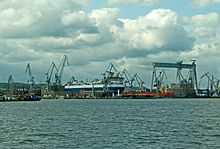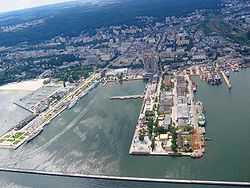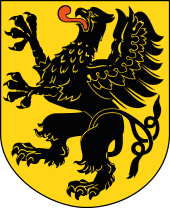Gdynia
| Gdynia | |||
|---|---|---|---|
 | |||
| |||
|
Motto: Uśmiechnij się, jesteś w Gdyni (Smile, you're in Gdynia) | |||
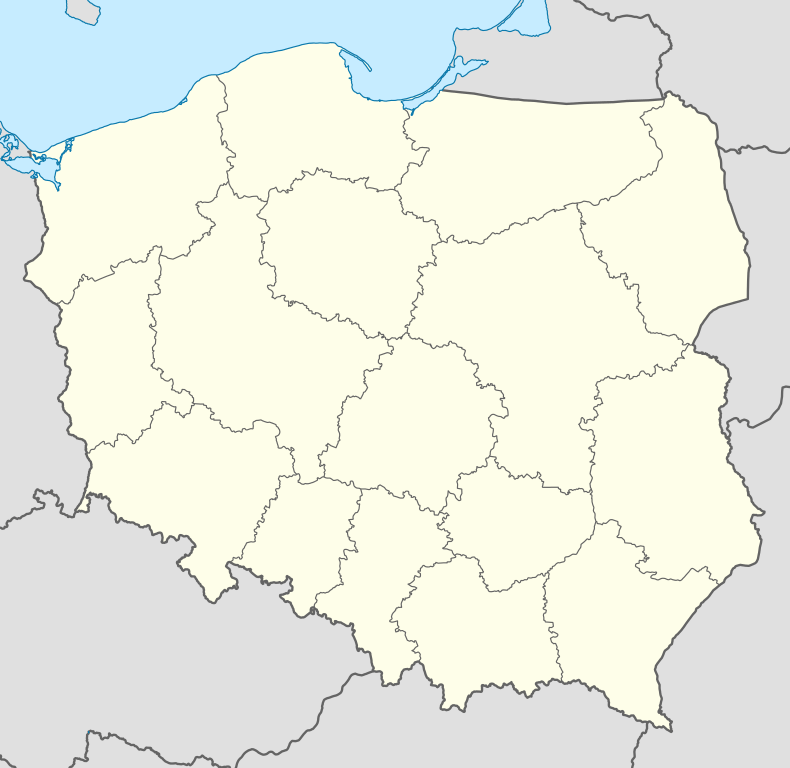 Gdynia | |||
| Coordinates: 54°30′N 18°32′E / 54.500°N 18.533°E | |||
| Country |
| ||
| Voivodeship | Pomeranian | ||
| County | city county | ||
| City rights | February 10, 1926 | ||
| Boroughs | 22 dzielnicas | ||
| Government | |||
| • Mayor | Wojciech Szczurek | ||
| • Vice President | Ewa Łowkiel | ||
| • Vice President | Michał Guć | ||
| • Vice President | Bogusław Stasiak | ||
| • Vice President | Marek Stępa | ||
| Area | |||
| • Total | 135 km2 (52 sq mi) | ||
| Highest elevation | 205 m (673 ft) | ||
| Lowest elevation | 0 m (0 ft) | ||
| Population (31.03.2014) | |||
| • Total | 247,799 | ||
| • Density | 1,800/km2 (4,800/sq mi) | ||
| Time zone | CET (UTC+1) | ||
| • Summer (DST) | CEST (UTC+2) | ||
| Postal code | 81-004 to 81-919 | ||
| Area code(s) | +48 58 | ||
| Car plates | GA | ||
| Website | http://www.gdynia.pl | ||
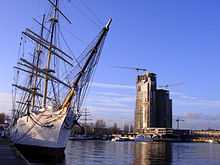
Gdynia [ˈɡdɨɲa] (Kashubian: Gdiniô, German: Gdingen; 1939–1945 Gotenhafen) is a city in the Pomeranian Voivodeship of Poland and an important seaport of Gdańsk Bay on the south coast of the Baltic Sea.
Located in Kashubia in Eastern Pomerania, Gdynia is part of a conurbation with the spa town of Sopot, the city of Gdańsk and suburban communities, which together form a metropolitan area called the Tricity (Trójmiasto), with a population of over a million people.
History
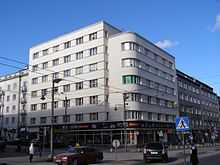
The area of the later city of Gdynia shared its history with Pomerelia (Eastern Pomerania); in prehistoric times it was the center of Oksywie culture; it was later populated by Slavs with some Baltic Prussian influences.
- Late 10th century: Pomerelia was united with Poland.[1]
- During the reign of Mieszko II Pomerelia seceded from Poland and became independent.
- 1116/1121: Bolesław III reunited Pomerelia with Poland.[2]
- 1209: First mention of Oxhöft (now known as Oksywie, which is now a part of Gdynia).
- 1227: Pomerelia again became an independent Duchy.
- 1253: First known mention of the name "Gdynia", as a Pomeranian (Kashubian) fishing village. The first church on this part of the Baltic Sea coast was built there.
- 1294: Pomerelia was inherited by the future Polish king Przemysł II., and remained as part of Poland until –
- 1309–1310; The Teutonic Order conquered Pomerelia and added it to Prussia.
- 1380: The owner of the village which became Gdynia, Peter from Rusocin, gave the village to the Cistercian Order.
- 1382: Gdynia became property of the Cistercian abbey in Oliva, now Oliwa.
- 1454; Thirteen Years' War started.
- 1466: Thirteen Years' War ended. Pomerelia became part of Royal Prussia, a newly established province of the Kingdom of Poland,[3] and later on of the Polish-Lithuanian Commonwealth.
- 1772: In the First Partition of Poland, Royal Prussia (including Gdynia) was annexed into the Kingdom of Prussia. Gdynia became known in German as Gdingen, and was expropriated from the Cistercian Order.
- 1789: There were only 21 houses in Gdynia.
- 1870:
- The Kingdom of Prussia became part of the German Empire.
- The village of Gdingen had some 1,200 inhabitants, and it was not a poor fishing village as it is sometimes described. It was a popular tourist spot with several guest houses, restaurants, cafes, several brick houses and a small harbour with a pier for small trading ships. The first Kashubian mayor of Gdingen was Jan Radtke.
- 1919: Treaty of Versailles and the start of the dismemberment of eastern Germany.
- 1920: Gdingen (now named Gdynia), along with other parts of former West Prussia, became a part of the new Republic of Poland; simultaneously, the city of Gdańsk and surrounding area was declared a free city and put under the League of Nations, though Poland was given economic liberties and requisitioned for matters of foreign representation.
Construction of the seaport
The decision to build a major seaport at the Gdynia village was made by the Polish government in the winter of 1920,[4] in the midst of the Polish-Soviet War (1919–1920).[5] The authorities and seaport workers of the Free City of Gdańsk felt Poland's economic rights in the city were being misappropriated to help fight the war. German dock workers went on strike, refusing to unload shipments of military supplies sent from the West to aid the Polish army,[5] and Poland realized the need for a port city it was in complete control of, economically and politically.
Construction of Gdynia seaport was started in 1921,[5] but because of financial difficulties was conducted slowly and with interruptions. It was accelerated after the Sejm (Polish parliament) passed the Gdynia Seaport Construction Act on 23 September 1922. By 1923 a 550-metre pier, 175 metres of a wooden tide breaker, and a small harbour had been constructed. Ceremonial inauguration of Gdynia as a temporary military port and fishers' shelter took place on 23 April 1923, and the first major seagoing ship arrived on 13 August 1923.
To speed up the construction works, the Polish government in November 1924 signed a contract with the French-Polish Consortium for Gdynia Seaport Construction, which by the end of 1925 had built a small seven-metre-deep harbour, the south pier, part of the north pier, a railway, and had also ordered the trans-shipment equipment. The works were going more slowly than expected, however. They accelerated only after May 1926, because of an increase in Polish exports by sea, economic prosperity, the outbreak of the German–Polish trade war which reverted most Polish international trade to sea routes, and also thanks to the personal engagement of Eugeniusz Kwiatkowski, Polish Minister of Industry and Trade, also responsible for construction of Centralny Okręg Przemysłowy. By the end of 1930 docks, piers, breakwaters and many auxiliary and industrial installations were constructed (such as depots, trans-shipment equipment, and a rice processing factory) or started (such as a large cold store).
Trans-shipments rose from 10,000 tons (1924) to 2,923,000 tons (1929). At this time Gdynia was the only transit and special seaport designed for coal exports. In the years 1931–1939 the Gdynia harbour was further extended to become a universal seaport. In 1938 Gdynia was the largest and most modern seaport on the Baltic Sea, as well as the tenth biggest in Europe. The trans-shipments rose to 8.7 million tons, which was 46% of Polish foreign trade. In 1938 the Gdynia shipyard started to build its first full-sea ship, the Olza.
Construction of the city

The city was constructed later than the seaport. In 1925 a special committee was inaugurated to build the city; city expansion plans were designed and city rights were granted in 1926, and tax privileges were granted for investors in 1927. The city started to grow significantly after 1928.
A new railway station and the Post Office were completed. The State railways extended their lines, built bridges and also constructed a group of houses for their employees. Within a few years houses were built along some 10 miles (16 km) of road leading northward from the Free City of Gdańsk to Gdynia and beyond. Public institutions and private employers helped their staffs to build houses.
In 1933 a plan of development providing for a population of 250,000 was worked out by a special commission appointed by a government committee, in collaboration with the municipal authorities. By 1939 the population had grown to over 120,000.[6]
During World War II (1939–1945)
The city and seaport were occupied in September 1939 by German troops and renamed Gotenhafen after the Goths, an ancient Germanic tribe, who had lived in the area. Some 50,000 Polish citizens, who after 1920 had been brought into the area by the Polish government after the decision to enlarge the harbour was made, were expelled to the General Government. Kashubians who were suspected to support the Polish cause, particularly those with higher education, were arrested and executed. The main place of execution was Piaśnica (Groß Plaßnitz), where about 12,000 were executed. The German gauleiter Albert Forster considered Kashubians of "low value" and did not support any attempts to create a Kashubian nationality. Some Kashubians organized anti-Nazi resistance groups, "Gryf Kaszubski" (later "Gryf Pomorski"), and the exiled "Zwiazek Pomorski" in Great Britain.
The harbour was transformed into a German naval base. The shipyard was expanded in 1940 and became a branch of the Kiel shipyard (Deutsche Werke Kiel A.G.). Gotenhafen became an important base, due to its being relatively distant from the war theater, and many German large ships—battleships and heavy cruisers—were anchored there. During 1942, Dr Joseph Goebbels authorized relocation of SS Cap Arcona to Gotenhafen Harbour as a stand-in for RMS Titanic during filming of the German-produced movie Titanic, directed by Herbert Selpin.
The city was also the location for the Nazi concentration camp Gotenhafen, a subcamp of the Stutthof concentration camp near Gdańsk.
The seaport and the shipyard both witnessed several air raids by the Allies from 1943 onwards, but suffered little damage. Gotenhafen was used during winter 1944–45 to evacuate German troops and refugees trapped by the Red Army. Some of the ships were hit by torpedoes from Soviet submarines in the Baltic Sea on the route West. The ship Wilhelm Gustloff sank, taking about 9,400 people with her – the worst loss of life in a single sinking in maritime history. The seaport area was largely destroyed by withdrawing German troops and millions of encircled refugees in 1945 being bombarded by Soviet Military (90% of the buildings and equipment were destroyed) and the harbour entrance was blocked by the German battleship Gneisenau that had been brought to Gotenhafen for major repairs.
After World War II
On March 28, 1945, Gotenhafen was captured by the Soviets and assigned to Polish Gdańsk Voivodeship, who again renamed it Gdynia.[4]
In the Polish 1970 protests, worker demonstrations took place at Gdynia Shipyard. Workers were fired upon by the police. The fallen (e.g. Brunon Drywa) became symbolized by a fictitious worker Janek Wiśniewski, commemorated in a song by Mieczysław Cholewa, Pieśń o Janku z Gdyni. One of Gdynia's important streets is named after Janek Wiśniewski. The same person was portrayed by Andrzej Wajda in his movie Man of Iron as Mateusz Birkut.
On December 4, 1999, a storm destroyed a huge crane in a shipyard, which was able to lift 900 tons.[7]
Climate
The climate of Gdynia is an oceanic climate owing to its position of the Baltic sea, which moderates the temperatures, compared to the interior of Poland. The climate is cool throughout the year and there is a somewhat uniform precipitation throughout the year. Typical of Northern Europe, there is little sunshine during the winter, but is very sunny (comparable to Milan, Italy) during the summer.
| Climate data for Gdynia (1976-2010) | |||||||||||||
|---|---|---|---|---|---|---|---|---|---|---|---|---|---|
| Month | Jan | Feb | Mar | Apr | May | Jun | Jul | Aug | Sep | Oct | Nov | Dec | Year |
| Record high °C (°F) | 13.7 (56.7) |
11.2 (52.2) |
16.0 (60.8) |
24.8 (76.6) |
30.2 (86.4) |
32.1 (89.8) |
34.7 (94.5) |
29.3 (84.7) |
28.5 (83.3) |
22.1 (71.8) |
15.2 (59.4) |
14.1 (57.4) |
34.7 (94.5) |
| Average high °C (°F) | 2.0 (35.6) |
2.8 (37) |
6.2 (43.2) |
11.6 (52.9) |
16.8 (62.2) |
20.4 (68.7) |
22.7 (72.9) |
22.5 (72.5) |
18.4 (65.1) |
12.2 (54) |
7.6 (45.7) |
4.3 (39.7) |
12.29 (54.13) |
| Daily mean °C (°F) | −0.6 (30.9) |
0.35 (32.63) |
2.25 (36.05) |
7.65 (45.77) |
12.0 (53.6) |
15.9 (60.6) |
18.75 (65.75) |
18.5 (65.3) |
15.1 (59.2) |
9.25 (48.65) |
5.65 (42.17) |
2.45 (36.41) |
8.938 (48.086) |
| Average low °C (°F) | −3.2 (26.2) |
−2.1 (28.2) |
−1.7 (28.9) |
3.7 (38.7) |
7.2 (45) |
11.4 (52.5) |
14.8 (58.6) |
14.5 (58.1) |
11.8 (53.2) |
6.3 (43.3) |
3.7 (38.7) |
0.6 (33.1) |
5.58 (42.04) |
| Record low °C (°F) | −21.2 (−6.2) |
−12.6 (9.3) |
−13.9 (7) |
−4.6 (23.7) |
−2.3 (27.9) |
4.7 (40.5) |
9.2 (48.6) |
7.7 (45.9) |
−4.6 (23.7) |
−3.8 (25.2) |
−5.2 (22.6) |
−14.5 (5.9) |
−21.2 (−6.2) |
| Average precipitation mm (inches) | 46.6 (1.835) |
40.6 (1.598) |
47.7 (1.878) |
36.6 (1.441) |
60.1 (2.366) |
59.6 (2.346) |
72.5 (2.854) |
74.9 (2.949) |
71.2 (2.803) |
67.8 (2.669) |
61.2 (2.409) |
57.8 (2.276) |
696.6 (27.424) |
| Avg. rainy days | 15 | 11 | 13 | 13 | 16 | 15 | 16 | 17 | 14 | 18 | 19 | 16 | 183 |
| Avg. snowy days | 11 | 13 | 10 | 2 | 0 | 0 | 0 | 0 | 0 | 1 | 6 | 7 | 50 |
| Average relative humidity (%) | 82 | 86 | 79 | 69 | 63 | 69 | 71 | 72 | 82 | 83 | 84 | 87 | 77.3 |
| Mean monthly sunshine hours | 41.7 | 57.1 | 124.0 | 192.0 | 286.7 | 294.4 | 281.3 | 247.8 | 194.2 | 107.8 | 48.7 | 22.6 | 1,898.3 |
| Source #1: my weather2[8] | |||||||||||||
| Source #2: Weather and Climate (sunshine hours)[9] | |||||||||||||
Economy
Notable companies that have their headquarters or regional offices in Gdynia:
- PROKOM SA, the largest Polish I.T. company
- C. Hartwig Gdynia SA, one of the largest Polish freight forwarders
- Sony Pictures – finance center
- Thomson Reuters – business data provider
- Vistal – bridge constructions, offshore and shipbuilding markets - partially located on old Stocznia Gdynia terrains
- Nauta - shiprepair yard - partially located on old Stocznia Gdynia terrains
- Crist - shipbuilding, offshore constructions, steel structures, sea engineering, civil engineering - located on old Stocznia Gdynia terrains
Former:
- Stocznia Gdynia, former largest Polish shipyard - now under bankruptcy procedures
- Nordea – banks - sold and consolidated with PKO bank
Transport
Port of Gdynia
In 2007, 364,202 passengers, 17,025,000 tons of Cargo and 614,373 TEU containers passed through the port. Regular car ferry service operates between here and Karlskrona, Sweden.
Airport
The conurbation's main airport, Gdańsk Lech Wałęsa Airport, lays approximately 25 kilometres (16 mi) south-west of central Gdynia, and has connections to approximately 55 destinations. It is the third largest airport in Poland.[10] A second General Aviation terminal is scheduled to be opened by May 2012, which will increase the airport's capacity to 5mln passengers per year.
Another local airport, (Gdynia-Kosakowo Airport) is situated partly in the village of Kosakowo, just to the north of the city, and partly in Gdynia. This has been a military airport since the World War II, but it has been decided in 2006 that the airport will be used to serve civilians.[11] Work was well in progress and was due to be ready for 2012 when the project collapsed following a February 2014 EU decision regarding Gdynia city funding as constituting unfair competition to Gdansk airport. In March 2014, the airport management company filed for bankruptcy, this being formally announced in May that year. The fate of some PLN 100 million of public funds from Gdynia remain unaccounted for with documents not being released, despite repeated requests for such from residents to the city president, Wojciech Szczurek.
Road transport
Trasa Kwiatkowskiego links Port of Gdynia and the city with Obwodnica Trójmiejska, and therefore A1 motorway.
Railways
The principal station in Gdynia is Gdynia Główna railway station, and Gdynia has five other railway stations. Local services are provided by the 'Fast Urban Railway,' Szybka Kolej Miejska (Tricity) operating frequent trains covering the Tricity area including Gdańsk, Sopot and Gdynia. Long distance trains from Warsaw via Gdańsk terminate at Gdynia, and there are direct trains to Poznań and other major cities. In 2011-2015 the Warsaw-Gdańsk-Gdynia route is undergoing a major upgrading costing $3 billion, partly funded by the European Investment Bank, including track replacement, realignment of curves and relocation of sections of track to allow speeds up to 200 km/h (124 mph), modernization of stations, and installation of the most modern ETCS signalling system, which is to be completed in June 2015. In December 2014 new Alstom Pendolino high-speed trains were put into service between Gdynia, Warsaw and Kraków reducing rail travel times to Gdynia by 2 hours.[12][13]
Education
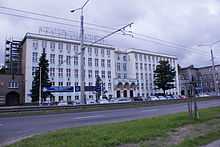
There are currently 8 universities and institutions of higher education based in Gdynia. Many students from Gdynia attend also universities located in the Tricity.
- State-owned:
- Gdynia Maritime University
- Polish Naval Academy
- University of Gdansk – departments of Biology, Geography and Oceanology
- Privately owned:
- Academy of International Economic and Political Relations
- Kwiatkowski Graduate School of Business Administration
- Pomeranian Higher School of Humanities
- Cardinal Stefan Wyszyński University – department in Gdynia
- Higher School of Social Communication
Culture
Gdynia hosts the Gdynia Film Festival, a major polish film festival. The International Random Film Festival will be hosted in Gdynia in November 2014.
Since 2003 Gdynia has been hosting the Open'er Festival, one of the biggest contemporary music festivals in Europe. The festival welcomes many foreign hip-hop, rock and electronic music artists every year. The lineup for 2015 is Mumford and Sons, Of Monsters and Men, The Prodigy, The Vaccines and many more.
Another important summer event in Gdynia is the Viva Beach Party, which is a large two-day techno party made on Gdynia's Public Beach and a summer-welcoming concerts CudaWianki. Gdynia also hosts events for the annual Gdańsk Shakespeare Festival.
In the summer of 2014 Gdynia hosted Red Bull Air Race World Championship.
Sports
Sport teams
- Arka Gdynia – men’s football team (Polish Cup winner 1979, currently plays in the second division of Polish football, the 1. liga)
- Bałtyk Gdynia – men's football team, playing in the 2nd league in the season 2009/2010;
- Lotos Gdynia – women’s basketball team (Polish Champion 2004 in Sharp Torell Basket Liga)
- Asseco Prokom Gdynia – men’s basketball team (Polish Basketball League and Euroleague)
- RC Arka Gdynia – rugby team (Champions of Poland in seasons 2003/2004, 2004/2005 and 2010/2011) [14]
- Seahawks Gdynia – American football team (Polish American Football League) (Champions of Poland in season 2011/2012)
- Kager Gdynia – men’s basketball team (Dominet Bank Ekstraliga)
- KS Łączpol Gdynia – women’s handball team (1st league in season 2003/2004)
Sights and tourist attractions
.jpg)
Gdynia is a relatively modern city. Its architecture includes the 13th century St. Michael the Archangel's Church in Oksywie, the oldest building in Gdynia, and the 17th century neo-Gothic manor house located on Folwarczna Street in Orłowo. The city also holds many examples of early 20th-century architecture, especially monumentalism and early functionalism, and modernism. A good example of modernism is PLO building situated at 10 Lutego Street.
The surrounding hills and the coastline attract many nature lovers. A leisure pier and a cliff-like coastline in Kępa Redłowska, as well as the surrounding Reservation Park, are also popular locations. In the harbour, there are two anchored museum ships, the ORP Blyskawica destroyer and the Dar Pomorza Tall ship frigate. A 1.5 kilometre long promenade leads from the marina in the city centre, to the beach in Redłowo.
Most of Gdynia can be seen from Kamienna Góra (54 metres asl) or the observation point near Chwaszczyno. There are also two observation towers, one at Góra Donas, the other at Kolibki.
Modern division into districts

- Babie Doły
- Chwarzno-Wiczlino
- Chylonia
- Cisowa
- Działki Leśne
- Dąbrowa
- Grabówek
- Kamienna Góra
- Karwiny
- Leszczynki
- Mały Kack
- Obłuże
- Oksywie
- Orłowo
- Pogórze
- Pustki Cisowskie
- Demptowo
- Redłowo
- Śródmieście
- Wielki Kack
- Witomino
- Wzgórze Św. Maksymiliana
Population and area
| Year | Inhabitants | Area |
|---|---|---|
| 1870 | 1200 | |
| 1920 | 1300 | |
| 1926 | 12,000 | 6 km² |
| 1939 | 127,000 | 66 km² |
| 1945 | 70,000 | 66 km² |
| 1960 | 150,200 | 73 km² |
| 1970 | 191,500 | 75 km² |
| 1975 | 221,100 | 134 km² |
| 1980 | 236,400 | 134 km² |
| 1990 | 251,500 | 136 km² |
| 1994 | 252,000 | 136 km² |
| 1995 | 251,400 | 136 km² |
| 2000 | 255,420 | 135.49 square kilometres (52.31 sq mi) (after GUS – Central Statistical Office in Warsaw) |
| 2009 | 248,889 | 136,72 km² |
Notable people
- Józef Michał Hubert Unrug (1884–1973), German-born Polish vice admiral who helped create the Polish navy
- Franciszek Stefan Sokół (1890–1956) Polish author, Commissioner of the government of Gdynia and the city's chief promoter and defender
- Karol Olgierd Borchardt (1905–1986), Polish maritime author and educator
- Kazimierz Ostrowski (1917 Berlin – 1999 Gdynia) Polish painter
- Zbigniew Szczepanek (b. 1933) Polish author of maritime textbooks, notable among watercolor artists in Europe
- Jacek Fedorowicz (b. 1937), Polish satirist and actor
- Gunnar Heinsohn (* 1943), German scientist
- Jörg Berger (*1944–2010), German soccer player, trainer
- Klaus Hurrelmann (* 1944), German scientist
- Franciszka Cegielska (1946–2000), Polish politician and Solidarity movement activist
- Marcin Mięciel (* 1975), soccer player
- Michael Klim (* 1977), Polish-born Australian swimmer, world champion
- Adam Darski, Behemoth frontman
- Stefan Liv, (1980–2011) Swedish ice hockey player
- Monika Pyrek Pole vaulter
- Anna Rogowska Pole vaulter
- Katya Douglas, British Actress (* 1938)
- Anna Przybylska, Polish actress (1978-2014)
- Alexandra Nice, Polish pornstar
- Pawel Anaszkiewicz, Polish-Mexican visual artist
- Joanna Malinowska, visual artist
International relations
Twin towns — sister cities
Gdynia is twinned with:
|
Cultural references
In 2008, Gdynia made it onto the Monopoly Here and Now World Edition board after being voted by fans through the Internet. Gdynia occupies the space traditionally held by Mediterranean Avenue, being the lowest voted city to make it onto the Monopoly Here and Now board, but also the smallest city to make it in the game. All of the other cities are large and widely known ones, the second smallest being Riga. The unexpected success of Gdynia can be attributed to a mobilization of the town's population to vote for it on the Internet.
| Free Parking | Sydney | Chance ? | New York | London | Monopoly Cruise | Beijing | Hong Kong | Wind Energy | Jerusalem | Go To Jail | |
| Vancouver |
| Paris | |||||||||
| Shanghai | Belgrade | ||||||||||
| Community Chest | Community Chest | ||||||||||
| Rome | Cape Town | ||||||||||
| Monopoly Air | Monopoly Space | ||||||||||
| Toronto | Chance ? | ||||||||||
| Kiev | Riga | ||||||||||
| Solar Energy | Super Tax pay | ||||||||||
| Istanbul | Montreal | ||||||||||
| In Jail/Just Visiting | Athens | Barcelona | Chance ? | Tokyo | Monopoly Rail | Income Tax pay | Taipei | Community Chest | Gdynia | Go Collect | |
An abandoned factory district in Gdynia was the scene for the survival series Man vs Wild, season 6, episode 12. The host, Bear Grylls, manages to escape the district after blowing up a door and crawling through miles of sewer.
Ernst Stavro Blofeld, the supervillain in the James Bond novels, was born in Gdynia on May 28, 1908, according to Thunderball.
See also
- Donas
- Gdynia trolleybus
- Ports of the Baltic Sea
References
- ↑ André Vauchez, Richard Barrie Dobson, Adrian Walford, Michael Lapidge,Encyclopedia of the Middle Ages, Routledge 2000, p.: 1163, ISBN 978-1-57958-282-1 link
- ↑ James Minahan, One Europe, Many Nations: A Historical Dictionary of European National Groups, Greenwood Publishing Group, 2000, p.375, ISBN 978-0-313-30984-7
- ↑ Daniel Stone,A History of East Central Europe, University of Washington Press, 2001, p. 30, ISBN 978-0-295-98093-5 Google Books
- ↑ 4.0 4.1 World Port Source – Gdynia
- ↑ 5.0 5.1 5.2 Robert Michael Citino. The path to blitzkrieg: doctrine and training in the German Army, 1920–1939. Lynne Rienner Publishers. 1999. p. 173.
- ↑ (ed) Michael Murray, Poland's Progress 1919–1939, John Murray, 1944, London pp 64–6
- ↑ "Catastrophic collapses of architectural structures in Poland". SkyscraperCity. Retrieved 2009-05-05.
- ↑ (in English). Weather 2 http://www.myweather2.com/City-Town/Poland/Gdynia/climate-profile.aspx. Retrieved March 31, 2015. Missing or empty
|title=(help) - ↑ "Weather and Climate for Gdynia, Poland". Weather-and-Climate. Retrieved March 31, 2015.
- ↑ Port Lotniczy Gdańsk im. Lecha Wałęsy. "Historia lotniska – Port Lotniczy Gdańsk im. Lecha Wałęsy". Airport.gdansk.pl. Retrieved 2013-03-12.
- ↑ "About airport | Port Lotniczy Gdynia-Kosakowo". Airport.gdynia.pl. Retrieved 2013-03-12.
- ↑ 'Polish Pendolino launches 200 km/h operation,' Railway Gazette Interrnational, 15 December 2014, http://www.railwaygazette.com/news/passenger/single-view/view/polish-pendolino-launches-200-kmh-operation.html
- ↑ 'Pendolino z Trójmiasta do Warszawy,' http://www.trojmiasto.pl/wiadomosci/Pendolino-z-Trojmiasta-do-Warszawy-Wiecej-pytan-niz-odpowiedzi-n71010.html
- ↑ "Historia Rugby Club Arka Gdynia". Arkarugby.pl. 2012-05-26. Retrieved 2013-03-12.
- ↑ "Aalborg Twin Towns". Europeprize.net. Retrieved 19 August 2013.
- ↑ "Aalborg Kommune – Venskabsbyer". Web.archive.org. 2007-11-14. Archived from the original on 2007-11-14. Retrieved 2009-07-26.
- ↑ Hassinen, Raino. "Kotka - International co-operation: Twin Cities". City of Kotka. Retrieved 2013-10-22.
- ↑ "Plymouth – Town Twinning". Plymouth City Council. Retrieved 2013-07-14.
Further reading
- (ed.) R. Wapiński, Dzieje Gdyni, Gdańsk 1980
- (ed.). S. Gierszewski, Gdynia, Gdańsk 1968
- Gdynia, in: Pomorze Gdańskie, nr 5, Gdańsk 1968
- J. Borowik, Gdynia, port Rzeczypospolitej, Toruń 1934
- B. Kasprowicz, Problemy ekonomiczne budowy i eksploatacji portu w Gdyni w latach 1920–1939, Zapiski Historyczne, nr 1-3/1956
- M. Widernik, Główne problemy gospodarczo-społeczne miasta Gdyni w latach 1926–1939., Gdańsk 1970
- (ed.) A. Bukowski, Gdynia. Sylwetki ludzi, oświata i nauka, literatura i kultura, Gdańsk 1979
- Gminy województwa gdańskiego, Gdańsk 1995
- H. Górnowicz, Z. Brocki, Nazwy miast Pomorza Gdańskiego, Wrocław 1978
- Gerard Labuda (ed.), Historia Pomorza, vol. I-IV, Poznań 1969–2003
- (ed.) W. Odyniec, Dzieje Pomorza Nadwiślańskiego od VII wieku do 1945 roku, Gdańsk 1978
- L. Bądkowski, Pomorska myśl polityczna, Gdańsk 1990
- L. Bądkowski, W. Samp, Poczet książąt Pomorza Gdańskiego, Gdańsk 1974
- B. Śliwiński, Poczet książąt gdańskich, Gdańsk 1997
- Józef Spors, Podziały administracyjne Pomorza Gdańskiego i Sławieńsko-Słupskiego od XII do początków XIV w, Słupsk 1983
- M. Latoszek, Pomorze. Zagadnienia etniczno-regionalne, Gdańsk 1996
- B. Bojarska, Eksterminacja inteligencji polskiej na Pomorzu Gdańskim (wrzesień-grudzień 1939), Poznań 1972
- K. Ciechanowski, Ruch oporu na Pomorzu Gdańskim 1939–1945., Warszawa 1972
External links
| Wikivoyage has a travel guide for Gdynia. |
| Wikimedia Commons has media related to Gdynia. |
| ||||||||||||||||||||
| ||||||||||||


